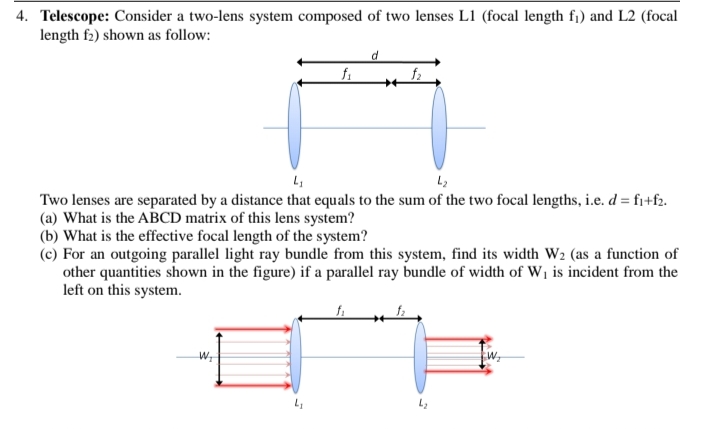Telescope: Consider a two-lens system composed of two lenses L1 (focal length fi) and L2 (focal length f2) shown as follow: Two lenses are separated by a distance that equals to the sum of the two focal lengths, i.e. d = fi+f2. (a) What is the ABCD matrix of this lens system? (b) What is the effective focal length of the system? (c) For an outgoing parallel light ray bundle from this system, find its width W2 (as a function of other quantities shown in the figure) if a parallel ray bundle of width of Wi is incident from the left on this system.
Telescope: Consider a two-lens system composed of two lenses L1 (focal length fi) and L2 (focal length f2) shown as follow: Two lenses are separated by a distance that equals to the sum of the two focal lengths, i.e. d = fi+f2. (a) What is the ABCD matrix of this lens system? (b) What is the effective focal length of the system? (c) For an outgoing parallel light ray bundle from this system, find its width W2 (as a function of other quantities shown in the figure) if a parallel ray bundle of width of Wi is incident from the left on this system.
Related questions
Question

Transcribed Image Text:Telescope: Consider a two-lens system composed of two lenses L1 (focal length fi) and L2 (focal
length f2) shown as follow:
Two lenses are separated by a distance that equals to the sum of the two focal lengths, i.e. d = fi+f2.
(a) What is the ABCD matrix of this lens system?
(b) What is the effective focal length of the system?
(c) For an outgoing parallel light ray bundle from this system, find its width W2 (as a function of
other quantities shown in the figure) if a parallel ray bundle of width of Wi is incident from the
left on this system.
Expert Solution
This question has been solved!
Explore an expertly crafted, step-by-step solution for a thorough understanding of key concepts.
This is a popular solution!
Trending now
This is a popular solution!
Step by step
Solved in 3 steps
